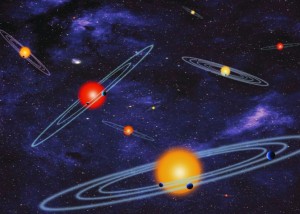University of Washington astronomer Eric Agol played a key role in the windfall of 715 new exoplanets announced by NASA Feb. 26. Agol was on a team that found seven of those worlds, all in orbit around the same star, Kepler-90. It’s the first planetary system with seven planets seen to transit, or cross in front of their host star.
 An artist’s illustration of multiple-transiting planet systems. The planets eclipse or transit their host star from the vantage point of the observer. Credit: NASA
An artist’s illustration of multiple-transiting planet systems. The planets eclipse or transit their host star from the vantage point of the observer. Credit: NASA
Agol, colleague Josh Carter of the Harvard-Smithsonian Center for Astrophysics and co-authors discovered the multiple planets (though other teams published findings before them) and helped confirm the high likelihood that the grouping is in fact a planetary system. Press reports note that an amateur astronomer assisted in identifying the seventh planet.
The worlds were all detected via the Kepler Space Telescope. Many of the newly verified systems have multiple planets. The 715 worlds orbit 305 different stars, and the great majority are planets smaller than Neptune.
In the seven-planet system Kepler-90 there are two worlds about the size of Earth, three super-Earths — planets larger in mass than Earth but less than 10 times so — and two much larger planets. The smaller planets orbit closer to the star and the bigger ones further out, as in our system.
The system is about 2,500 light-years away, in the area of the Draco constellation. A light-year, the distance light travels in a year, is about 6 trillion miles. It’s a tightly packed grouping, too; the outermost planet orbits the host star at about the same distance Earth is from the sun.
Four of the 715 newly discovered worlds are less than 2.5 times the size of Earth and their orbits are within their host star’s habitable zone, the swath of space just right for an orbiting planet’s surface water to be in liquid form, thus potentially giving life a chance.
The NASA discovery substantially brings to 1,700 the total number of confirmed exoplanets, or worlds beyond our own solar system. Visit online for more information about the Kepler mission.